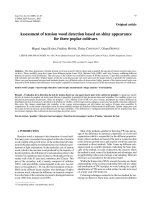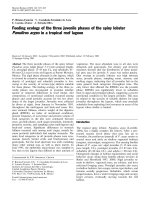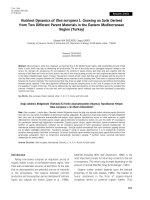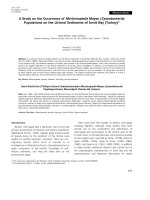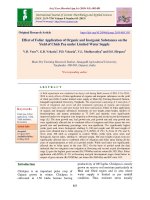Prevalence of gastrointestinal nematode infection in goats
Bạn đang xem bản rút gọn của tài liệu. Xem và tải ngay bản đầy đủ của tài liệu tại đây (184.84 KB, 7 trang )
Int.J.Curr.Microbiol.App.Sci (2020) 9(8): 1238-1244
International Journal of Current Microbiology and Applied Sciences
ISSN: 2319-7706 Volume 9 Number 8 (2020)
Journal homepage:
Original Research Article
/>
Prevalence of Gastrointestinal Nematode Infection in Goats
Pritish Dhamdar, S. L. Ali, D. Bhonsle, S. Shakya, S. Roy, O. P. Dinani*,
S. K. Deshmukh and Jasmeet Singh
College of Veterinary Science and A.H.Anjora, Chhattisgarh Kamdhenu University,
Durg-491001, India
*Corresponding author
ABSTRACT
Keywords
Nematodiasis, Goat,
Faecal samples,
Gastrointestinal,
Strongyloides spp,
Trichuris spp
Article Info
Accepted:
15 July 2020
Available Online:
10 August 2020
The prevalence of gastrointestinal nematodiasis was studied on goats in the
three villages of Durg and Jagdalpur region of Chhattisgarh state in India.
A total number of 380 goats irrespective of breed, age and sex were
examined for a period of 6 months for the study. Gross and microscopic
examinations were done from collected faecal samples for the presence of
nematodes. The overall prevalence of gastrointestinal nematode infection
was 43.88% with 47.70% and 40% at Jagdalpur and Durg regions
respectively with maximum incidence in July month. The Strongyloides
spp was more prominent in Jagdalpur (54.00%) whereas Trichuris spp was
(49.00%) more prominent in Durg region, respectively.
Introduction
India has the largest livestock population in
the world which contributes about 7.0% to its
national income. Livestock is an important
integral component of agriculture in India and
contributes immensely to the rural economy
of the country (Chowdhury, 2002). Livestock
sector plays a critical role in the welfare of
India’s rural population. Small ruminant
rearing is an asset of livelihood for the
farmers among poor and developing
countries. It contributes nine percent to Gross
Domestic Product (GDP) and employs eight
percent of the labor force. This sector
witnessed significant increase in output of its
products like meat, milk and skin. Goat has a
tremendous potential to adapt in harsh agroclimatic conditions, thus suitable to large
number of rural households of entire country.
Owing to increase in per capita income and
buying capacity of the individual and dietary
consciousness, the demand for the goat
products has also increased. Besides low
capital investment and recurring cost, quick
return and less risk attracted the variety of
households towards profitable and sustainable
goat farming (Singh et al., 2013).
1238
Int.J.Curr.Microbiol.App.Sci (2020) 9(8): 1238-1244
Among
various
ailments
of
goat
gastrointestinal
parasitism
has
been
recognized as a major health issue in small
ruminant production systems and its
consequence can be extensive ranging from
reduced performance to mortality (Sykes,
1994). Prominent nematode that infect goat
and sheep are Haemonchus contortus,
Trichostrongylus
columbriformis
Teladorsagia circumcinta, Cooperia spp.,
Nematodiruss pathiger, Oesophagostomum
spp., Trichuris spp., Dictyocaulus filaria and
Strongyloides papillosus. Further goats are
more susceptible to
infection with
gastrointestinal nematodes than sheep.
Among the various helminths, nematodes are
considered to be of utmost importance on the
basis of their prevalence and adverse effect
worldwide (Mini et al., 2013) and responsible
for inflicting huge economic loss to the goat
industry (Jallow et al., 1994).
out the rate of prevalence of such helminthic
infection in Chhattisgarh state also.
Materials and Methods
The
prevalence
of
gastrointestinal
nematodiasis was observed mainly on goats in
the three villages of Durg and Jagdalpur
region. A total number of 380 goats
irrespective of breed, age and sex were
examined for a period of 6 months for the
study. The prevalence of gastrointestinal
nematode infection was calculated by
considering total number of goats screened
for gastrointestinal nematode infection and
number of goats detected positive as per the
formula Gastrointestinal helminth infection
(%) =No. of gastrointestinal nematode
infection cases detected/ Total no. of goats
screened for gastrointestinal infection X100.
Collection of clinical samples
The gut helminths induce many functional
disturbances in the host body including
metabolic changes, retardation of growth,
weight loss, haemato-biochemical changes
and increased susceptibility to a variety of
diseases (Khan et al., 2015; Fleming et al.,
2006)). Nematodes that are dependent on
blood prehension such as Haemonchus
contortus induce specific clinical and
subclinical symptoms (Khanolkar, 2018). As
a result, decreased digestibility of food and
diversion of nutrient towards repair of tissue
damage leads to disturbances in the
hematological, biochemical parameters of the
host (Sykes, 1994; Venkatesh et al., 2013).
The available literature indicates that similar
studies on the prevalence of gastrointestinal
helminthic infection and their effects on goats
have been conducted in various states in our
country.
However,
meager
literature
regarding prevalence of gastrointestinal
nematode in goats of Chhattisgarh state is
available. Therefore, it is imperative to find
Faecal sample of about 5 gm from each
animal was collected in a zip lock cover from
individual goats per-rectally. Care was taken
to avoid intermixing and gross contamination
of faecal sample with urine or bedding
materials. Fortnight visits were made for
collection and for studying the prevalence of
nematode helminths. The processing and
examining were done macroscopically as well
as microscopically by the method as
described by Soulsby (1982) and Ruprah et
al., (1986). Gross and microscopic
examination of collected faecal samples was
done for the presence of nematodes.
Microscopic examination of faecal samples
was carried out as follows.
Direct Smear Technique
A small quantity of faecal material was taken
on a glass slide with the help of glass rod and
mixed with 4-5 drops of water and covered
with coverslip and examined under 10x power
1239
Int.J.Curr.Microbiol.App.Sci (2020) 9(8): 1238-1244
of microscope to detect parasitic eggs/ larvae.
The samples found negative were subjected to
further examination.
employing t-test as per the methods described
by Snedecor and Cochran (1967) and oneway ANOVA using Statistical Package for
Social Sciences (SPSS).
Sedimentation technique
Results and Discussion
About 3-5 gm of faeces was emulsified with
20-30 ml of water in beaker. The content was
strained into a sedimentation flask. The flask
was filled upto its brim with water or saline
and allowed to stand for 20 minutes. The
supernatant was thrown off. This process was
repeated until the clear supernatant is
obtained· After last sedimentation the
supernatant was discarded and drop of
sediment was taken on clean glass slide,
covered with coverslip and examined thrice
under low power of microscope to detect the
presence of trematode/ nematode eggs/ larvae,
as directed by Ruprah et al., (1986).
The current study was conducted in the
various regions of Jagdalpur and Durg.
During the study 360 goats were examined of
180 in each of the mentioned regions out of
which 86 and 72 goats were found positive
from Jagdalpur and Durg region respectively.
The month wise percentage of total positive
goats out of total examined goats in Jagdalpur
and Durg region. respectively. The overall of
prevalence of nematodes recorded was
47.78% (Table 1 and 2) and 40% in Jagdalpur
and Durg respectively. Table 3 shows various
localities of Durg and Jagdalpur region of
sample collections.
Quantitative examination
The faecal samples of heavily infected
animals were taken up for quantitative
examination to estimate Egg Per Gram (EPG)
of faeces. The Stoll's technique as described
by Soulsby (1982) was used. In this technique
3 gm of faecal sample was taken in 100 ml
glass beaker to which tap water was added to
make volume 45 ml.
The solution was homogenized with the help
of automatic magnetic homoginator. From
this solution 0.15-ml quantity was taken with
the help of graduated pipette on glass slide.
After putting a rectangular coverslip, the slide
examined under low power microscope and
the egg number was counted. Eggs per gram
were counted by multiplying the number of
eggs by dilution factor 100.
Statistical analysis
The numerical data collected from the
obtained results was statistically analysed by
These findings are near in resemblance with
Akhter et al., (2011) who reported 43.10% of
the overall prevalence. Nabi et al., (2014) also
reported that the overall incidence of
gastrointestinal
parasite
in
goat
in
Pakhtumkhwa region of Pakistan to be
40.67%. However, Javaid et al., (2018)
showed higher prevalence rate of 70.55%.
gastrointestinal nematodes in goats. Similarly,
much higher prevalence of 86.8 was reported
by Yadav and Tandon (1989), than recorded
in the present studies.
The variability in the overall prevalence of
gastrointestinal nematode infections might be
due to variation in agro- climatic conditions
of the region which could affect the
survivability and development of infective
larval stage of nematode parasites. Further the
use of various anthelmintic and grazing
practices adopted might have contributed for
the difference in the rate of incidence
(Getachew et al., 2017).
1240
Int.J.Curr.Microbiol.App.Sci (2020) 9(8): 1238-1244
Table.1 Month wise prevalence of Helminths infections in goats of Jagdalpur region (C.G)
Month
No of goats examined
No of goat positive
February
March
April
May
June
July
Total
35
25
29
31
20
40
180
18
13
13
8
9
25
86
Percentage of
infection (%)
51.43
52.0
44.82
25.80
45.0
62.50
47.78
Table.2 Month wise prevalence of Helminths infections in goats of Durg region (C.G)
Month
No of goats
examined
30
25
28
25
37
35
180
February
March
April
May
June
July
Total
No of goat positive
14
11
10
9
11
17
72
Percentage of
infection (%)
46.66
44.0
35.71
36.0
29.72
48.57
40
Table.3 Prevalence of Nematode infection in goats of different localities of Durg and Jagdalpur
region
S.NO
Location
No. of
samples
examined
1
2
3
4
Anjora
Thannod
Nagpura
TOTAL
90
50
40
180
1
2
3
4
5
Kangoli
Tetarkhuti
Kilepal
Palli
TOTAL
60
30
49
41
180
1241
No. of
samples
positive
Durg region
29
23
20
72
Jagdalpur region
25
18
24
19
86
% of
infection
16.11
12.78
11.11
40
15.00
10.
12.22
10.56
47.78
Int.J.Curr.Microbiol.App.Sci (2020) 9(8): 1238-1244
Table.4 Species wise prevalence of G.I nematodes in Jagdalpur region
Month
Feb
Mar
Apr
May
June
July
Total
Total
examined
35
25
29
31
20
40
180
Total
positive
18
13
13
8
9
25
86
Strongyle
(%)
4(11.42)
3(12)
2(6.89)
1(3.22)
1(5)
3(7.5)
14(16.27)
Strongyloides
(%)
8( 22.85)
6(24)
7( 24.13)
4( 12.90)
5(25)
16( 40)
46(53.4)
Trichuris
(%)
6(17.14)
4(16)
4(13.79)
2(6.45)
3(12)
6( 15)
25(29.06)
Table.5 Species wise prevalence of G.I nematodes in Durg region
Month
Feb
Mar
Apr
May
June
July
Total
Total
examined
30
25
28
25
37
35
180
Total
positive
14
11
10
9
11
17
72
Strongyle
(%)
3(10)
2(5.40)
3(10.71)
1(4)
3(12)
4(11.42)
16(22.22)
The current study witnessed significantly
higher incidence of GI nematodes (62.5% in
Jagdalpur and 48.75% in Durg during the
initiation of monsoon season i.e. July month
(Table 1 and 2) which is in accordance with
the findings Deshpande et al., (2001), Sharma
et al., (2009), Barua et al., (2015), Singh et
al., (2015) and Thakuria et al., (2015). The
highest incidence of GI nematodes in
monsoon might be due to the presence of
adequate moisture and temperature in the
environment which might have favored
increased frequency of transmission of the
infective larvae to the final host.
Table 4 and 5 depict Strongyloides spp 53.4%
and 29.16%, Strongyle spp 16.27% and
22.22% Trichuris spp 29.06% and 48.16%
among 86 and 72 positive goats of Jagdalpur
and Durg region respectively. Strongyloides
spp were most predominant in Jagdalpur
Strongyloides
(%)
3(10)
4(10.81)
3(10.71)
3(12)
2(8)
6(17.14)
21(29.16)
Trichuris
(%)
8(26.66)
5(13.51)
4(14.28)
5(20)
6(24)
7(20)
35(48.61)
region than Strongyle spp and Trichuris spp.
Predominance of Strongyloides spp over
Strongyle and Trichuris spp has also been
reported by Yusof and Isa (2016). On the
contrary
Trichuris
spp
were
more
predominant in Durg as compared to
Strongyle spp and Strongyloides spp. These
findings are in accordance with the findings
of Shakya et al., (2017) reporting
predominance of Strongyle spp in mhow
region of Madhyapradesh. Prevalence of
nematode infection in the various localities of
Durg and Jagdalpur are presented in Table 3
showing 16.11%, 12.78% and 11.11% of
nematode prevalence was recorded in Anjora,
Thannod, and Nagpura localities of Durg
respectively. Similarly, in the Kangoli,
Tetarkhuti, Kilepal and Palli localities of
Jagdalpur region the prevalence recorded was
15.0%, 10.0%, 12.22% and 10.56%. Species
wise prevalence from the month February to
1242
Int.J.Curr.Microbiol.App.Sci (2020) 9(8): 1238-1244
July in Jagdalpur and Durg region is
presented in Table 4 and 5 respectively. At
Jagdalpur the prevalence of Strongyle in the
month of February, March, April, May, June
and July was 11.42%,12 %,6.89%, 3.22%,5%
and 7.5%, respectively. Prevalence of
Strongyloides recorded in the month of
February, March, April, May, June and July
was 22.85%, 24%, 24.13%, 12.90%, 25%,
and 40% respectively. Similarly, 17.14%,
16%, 13.79%, 6.45%, 12% and 15% of
prevalence was recorded for Trichuris in the
month of February, March, April, May, June
and July respectively. At Durg the prevalence
of Strongyle in the month of February, March,
April, May, June and July was 10%, 5.40%,
10.71%, 4.0%, 12.0% and 11.42%.
respectively. Prevalence of Strongyloides
recorded in the month of February, March,
April, May, June and July was 10.0%,
10.81%, 10.71, 12%, 8%, and 17.14%
respectively. Similarly, 26.66%, 13.51%,
14.28%, 20.0%, 24.0% and 20.0% of
prevalence was recorded for Trichuris in the
month of February March, April, May, June,
and July respectively.
In conclusions the current study was carried
out in and around Durg and Jagdalpur region
of Chhattisgarh state. The overall prevalence
of gastrointestinal nematode was 40% in Durg
and 47.78 % in Jagdalpur with its maximum
intensity in the month of July. The overall
prevalence of gastrointestinal nematode
infection was 43.88% with 47.70% and 40%
at Jagdalpur and Durg regions respectively
with maximum incidence in July month. The
Strongyloides spp was more prominent in
Jagdalpur (54.00%) whereas Trichuris spp
was (49.00%) more prominent in Durg region
respectively.
References
Akhter, N., Arijo, A. G., Phulan, M. S., Iqbal,
Z., and Mirbahar, K. B. (2011).
Prevalence of gastro-intestinal nematodes
in goats in Hyderabad and adjoining
areas. Pak Vet J, 31(4), 287-290.
Barua, C. C., Hazorika, M., Saleque, A., Bora,
P., and Das, P. (2015). Prevalence of
gastrointestinal helminth infections in
goats at Goat Research Station, Byrnihat.
International Journal of Advanced
Research in Biological Sciences, 2, 297305.
Chowdhury, N. (2002). Epidemiology of
helminths of livestock in Indian
subcontinent. J Vet Parasitol, 16: 79-87.
Deshpande, A.V., Deshpande, P. D. and
Narladkar, B.W. (2001). Seasonal
prevalence of round worm in ruminants of
Marathwada region and its correlation
with environmental factors. Proceeding of
XIIth National Congress of Veterinary
Parasitolgy, pp. 51.
Fleming, S. A., Craig, T., Kaplan, R. M., Miller,
J. E., Navarre, C., and Rings, M. (2006).
Anthelmintic resistance of gastrointestinal
parasites in small ruminants. Journal of
veterinary internal medicine, 20(2), 435444.
Getachew, M., Tesfaye, R. and Sisay, E. (2017).
Prevalence
and
risk factors
of
gastrointestinal nematodes infections in
small ruminants in Tullo District, Western
Harerghe, Ethiopia. Journal of Veterinary
Science Technology, 8(428), 1-8.
Jallow, O. A., McGregor, B. A., Anderson, N.,
and Holmes, J. H. G. (1994). Intake of
trichostrongylid larvae by goats and sheep
grazing together. Australian Veterinary
Journal, 71(11), 361-364.
Javaid, M., Rashid, M., Nabi, B., Mudasir, M.,
Bhat, M., Wani, N., and Bhat, M. (2018).
Prevalence of Gastrointestinal Nematodes
in Sheep and Goats Reared by Nomads of
Jammu Region of Jammu and Kashmir.
International Journal of Livestock
Research, 8(8), 219-225.
Khan, M. A., Roohi, N., and Rana, M. A. A.
(2015). Strongylosis in equines: a review.
J Anim Plant Sci, 25, 1-9.
Khanolkar, V. M. (2018). Evaluation of
Polyherbal Anthelmintic Formulation
Against Haemonchosis in Goats (Doctoral
1243
Int.J.Curr.Microbiol.App.Sci (2020) 9(8): 1238-1244
dissertation, MAFSU, Nagpur).
K. P. K. V. Venkateswaran, S.
Gomathinayagam, S. Bijargi and P. K.
Mandal (2013) Anthelmintic Activity of
Plants Especially of Aristolochia Species
in Haemonchosis: A Review. Asian J.
Anim. Vet. Adv. 10 (10): 623-645.
Nabi, H., Saeed, K., Shah, S. R., Rashid, M. I.,
Akbar, H., and Shehzad, W. (2014).
Epidimiological study of gastrointestinal
nematodes of goats in District Swat,
Khyber Pakhtunkhwa, Pakistan. Science
International, 26(1).
Rupah, N.S., Choudhary, S.S and Gupta, S.K.
(1996)
Paristological
manual-I
Directorate of publications, Haryana
Agriculture University, Hissar, (India).
Shakya, P., Jayraw, A. K., Jamra, N., Agrawal,
V., and Jatav, G. P. (2017). Incidence of
gastrointestinal nematodes in goats in and
around Mhow, Madhya Pradesh. Journal
of parasitic diseases, 41(4), 963-967.
Sharma, D. K., Agrawal, N., Mandal, A.,
Nigam, P., and Bhushan, S. (2009).
Coccidia and gastrointestinal nematode
infections in semi-intensively managed
Jakhrana goats of semi-arid region of
India.
Tropical
and
Subtropical
Agroecosystems, 11(1), 135-139.
Singh, A. K., Das, G., Roy, B., Nath, S.,
Naresh, R. and Kumar, S. (2015).
Prevalence of gastrointestinal parasitic
infections in goat of Madhya Pradesh,
India. Journal of Parasitic Diseases,
39(4), 716-719.
Singh, M. K., Dixit, A. K., Roy, A. K., and
Singh, S. K. (2013). Goat rearing: A
Mini,
pathway for sustainable livelihood
security
in
Bundelkhand
region.
Agricultural Economics Research Review,
26(347-2016-17095), 79-88.
Snedecor, G. W., and Cochran, W. G. (1967).
Statistical methods. Iowa state. University
Press, 327, 12.
Soulsby, E. J. L. (1982). Helminths. Arthropods
and Protozoa of domesticated animals,
291.
Sykes, A. R. (1994). Parasitism and production
in farm animals. Animal Science, 59(2):
155-172.
Thakuria M, Dutta TC, Phukan A, Islam S,
Saleque A, Baruah N. (2015). Seasonal
prevalence of gastrointestinal nematodes
in goats in Assam. Indian Vet J., 92:74–
75.
Venkatesh, K. V., Girish, K. K., Pradeepa, K.,
and Santosh, K. S. R. (2013).
Antibacterial activity of ethanol extract of
Musa paradisiaca CV. Puttabale and
Musa acuminate CV. Grand Naine. Asian
J Pharm Clin Res, 6(Suppl 2), 169- 172.
Yadav, A. K., and Tandon, V. (1989).
Gastrointestinal nematode infections of
goats in a sub-tropical and humid zone of
India. Veterinary parasitology, 33(2),
135- 142.
Yusof, A. M., and Isa, M. L. M. (2016).
Prevalence
of
gastrointestinal
nematodiasis and coccidiosis in goats
from three selected farms in Terengganu,
Malaysia. Asian Pacific journal of
tropical biomedicine, 6(9), 735-739.
How to cite this article:
Pritish Dhamdar, S. L. Ali, D. Bhonsle, S. Shakya, S. Roy, O. P.Dinani, S. K. Deshmukh and
Jasmeet Singh. 2020. Prevalence of Gastrointestinal Nematode Infection in Goats.
Int.J.Curr.Microbiol.App.Sci. 9(08): 1238-1244. doi: />
1244
